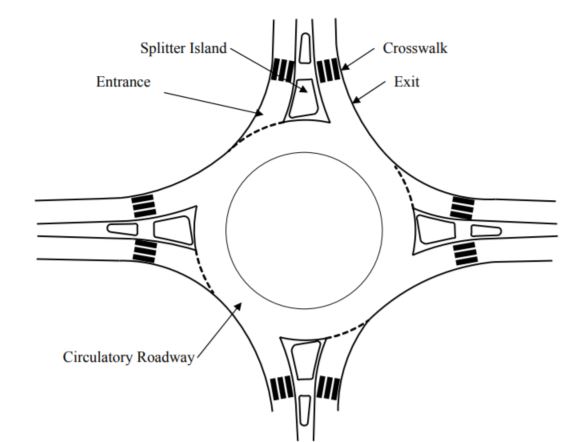Synthesis of Literature Relevant to Roundabout Signalization to Provide Pedestrian Access - Final Report
ROUNDABOUT OVERVIEW
As defined by the Federal Highway Administration (FHWA), modern roundabouts are circular intersections with specific traffic control and design features (7). These features include yield control at entry, channelized approaches, and geometric approach curvature (deflection) to induce entering traffic to slow to the design speed of the circulatory roadway. Figure 1 illustrates the typical locations for crosswalks at roundabouts in the U.S. One end of each crosswalk terminates on a splitter island so that the pedestrian crosses only one direction of traffic at a time. The crosswalks are set back from the intersection to minimize conflicts with turning vehicles.1 Traffic is forced to travel on a curved path, which typically minimizes vehicle speed to between 20 and 30 mi/h.
Figure 1. Illustration of single-lane roundabout with crosswalks
Roundabouts are appearing with increasing frequency in the United States, primarily because of their benefits to traffic operations and safety. Compared to conventional intersections, potential roundabout benefits identified in the FHWA informational guide (7) include: less vehicle delay, fewer crashes, and fewer serious and fatal injuries in crashes, both for vehicle occupants and for pedestrians.
1 It has been pointed out that setting crosswalks back at roundabout is opposite of the policy at traditional intersections where the crosswalks are as close as practicable to the intersection. This apparent contradiction results in part from the fundamental difference between roundabouts and traditional intersections. At roundabouts traffic flow is continuous and there is no pedestrian phase. At traditional traffic device controlled intersections, priority usually alternates between conflicting approaches (i.e., with traffic signal control) or remains with the predominate approach (e.g., with two-way stop control). At roundabouts, placing the crosswalk at the edge of the inscribed circle (juxtaposed to the circular roadway) would expose pedestrians to nearly continuous traffic that approaches from both the side and rear. At the entrance drivers would need to split their attention between possible pedestrians approaching the right and vehicles approaching from the left. Moving the crosswalk back from the circular roadway eliminates the threat to pedestrians from vehicles that approach from the rear and places pedestrians in the drivers’ forward field of vision. At controlled traditional intersections pedestrians can take advantage of the traffic control to obtain a gap, an option not generally available at U.S. roundabouts, and drivers can scan for pedestrians while they are stopped for the control. The right-turn-on-red prohibition when pedestrians are present is intended to eliminate the conflict in which drivers must attend to both pedestrians on their right and approaching vehicles on their left. When roundabouts are signalized, there may be some advantage to moving crosswalks to be proximal to the circular roadway and this is done at fully signalized roundabouts (see Figure 5 for an example in France). However, fully signalized roundabouts are much larger than the “modern roundabouts” currently being built in the U.S., which do not have sufficient space to store vehicles in the circular roadway without stopping traffic flow in all directions and thus eliminating the cost and efficiency benefits that are the hallmark advantages of modern roundabouts.


User Comments/Questions
Add Comment/Question